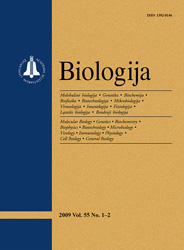Biologija / Biology
 ISSN 1392-0146 ISSN 2029-0578 (online) |
2005 m. Nr. 4 Escherichia coli dinJ-yafQ operon shows characteristic
features of bacterial toxin–antitoxin modules
Bacterial toxin–antitoxin (TA) systems are pairs of genes which constitute an operon and code for a stable toxic protein and a labile antitoxin. The antitoxin neutralizes the toxin’s inhibitory effect on cell growth and viability via direct protein–protein interactions. TA modules are widespread on the chromosomes of free-living bacteria and archaea, including many pathogens, where they presumably act as stress response elements. The chromosome of Escherichia coli K-12 encodes four known TA pairs, as well as the dinJ-yafQ operon, which is hypothesized to be a TA module based on similar operon organization to known TA genes. We have cloned the genes from the dinJ-yafQ operon of E. coli separately and together. Expression of YafQ protein from a low-copy number tightly regulated expression plasmid inhibited cell growth, but did not cause a reduction in viable cell counts. Concomitant expression of DinJ counteracted the toxic effect of YafQ. Thus, dinJ-yafQ exhibits the characteristics of an active TA module. Homologues of E. coli dinJ and yafQ genes were found in a variety of bacterial species. Sequence alignment of DinJ and YafQ homologues and other most similar TA protein pairs from bacteria and archaea has revealed that E. coli DinJ and YafQ possess conservative amino acids shown to be important for protein–protein interactions and toxin catalytic activity.
Keywords: chromosomal toxin-antitoxin systems, dinJ-yafQ operon, E.coli stress response |
Issues:
2011 - Vol.57 No. 1, No. 2, No. 3 2010 - Vol.56 No. 1-4 2009 - Vol.55 No. 1-2, No. 3-4 2008 - Vol.54 No. 1, No. 2, No. 3, No. 4 2007 - Vol.53 No. 1, No. 2, No. 3, No. 4 2006 No. 1, No. 2, No. 3, No. 4 2005 No. 1, No. 2, No. 3, No. 4 2004 No. 1, No. 2, No. 3, No. 4 2003 No. 1, No. 2, No. 3, No. 4 2002 No. 1, No. 2, No. 3, No. 4 2001 No. 1, No. 2, No. 3, No. 4 |